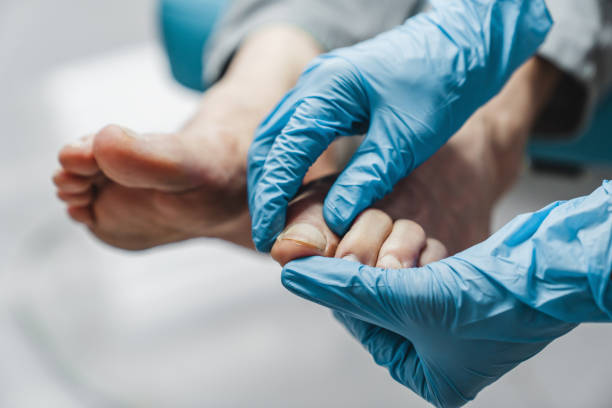
Few things can disrupt your day-to-day life like the discomfort of an ingrown toenail. This common condition occurs when the edge of a toenail grows into the surrounding skin, leading to pain, swelling, and sometimes infection. While ingrown toenails can be a source of considerable discomfort, there are several effective strategies for relief and prevention. In this guide, we will explore the causes of ingrown toenails, methods for relief, and tips for preventing their recurrence.
Understanding Ingrown Toenails
To understand how to effectively treat ingrown toenails, it’s essential to first grasp their underlying causes. Several factors contribute to the development of ingrown toenails, including:
- Improper Trimming: Cutting toenails too short or rounding the edges rather than cutting straight across can encourage the nail to grow into the surrounding skin.
- Ill-Fitting Footwear: Shoes that are too tight or narrow can exert pressure on the toes, pushing the nails into the skin.
- Trauma or Injury: Stubbing the toe or dropping something heavy on it can cause the nail to grow abnormally.
- Genetics: Some individuals inherit a predisposition to ingrown toenails due to the shape and structure of their nails.
- Fungal Infections: Conditions such as athlete’s foot can weaken the nail and surrounding skin, making them more susceptible to ingrowth.
Relief and Treatment
Fortunately, there are several effective methods for relieving the discomfort associated with ingrown toenails. These include:
- Warm Water Soaks: Soaking the affected foot in warm, soapy water can help soften the skin and reduce inflammation. Aim for 15-20 minutes of soaking, two to three times per day.
- Gentle Nail Trimming: If the ingrown nail is not too severe, carefully trimming the offending edge can provide temporary relief. Use clean, sanitized nail clippers, and be sure to cut straight across, avoiding rounding the edges.
- Cotton Wedge Technique: Placing a small piece of cotton or dental floss under the ingrown edge of the nail can help lift it away from the skin, providing relief from pressure and reducing the risk of infection.
- Topical Treatments: Over-the-counter antiseptic creams or ointments can help prevent infection and promote healing. Look for products containing ingredients such as tea tree oil or hydrogen peroxide.
- Pain Management: Over-the-counter pain relievers such as ibuprofen or acetaminophen can help alleviate discomfort while the ingrown toenail heals.
In more severe cases or those accompanied by signs of infection such as pus or excessive redness, it’s essential to seek medical attention. A podiatrist High Wycombe or a foot specialist can provide professional treatment, which may include:
- Partial Nail Removal: In cases where the ingrown toenail is recurring or severe, a podiatrist Guildford may recommend removing a portion of the nail to allow the affected area to heal properly.
- Nail Matrixectomy: This surgical procedure involves removing the portion of the nail matrix responsible for nail growth, preventing the ingrown nail from recurring.
- Antibiotics: If the ingrown toenail has become infected, oral or topical antibiotics may be prescribed to clear the infection and prevent it from spreading.
Prevention Strategies
While treating an existing ingrown toenail is essential for relief, taking steps to prevent its recurrence is equally important. Here are some tips for preventing ingrown toenails:
- Proper Nail Care: Trim toenails straight across, avoiding rounded edges, and keep them at a moderate length to reduce the risk of ingrowth.
- Wear Proper Footwear: Choose shoes with a wide toe box that allows plenty of room for your toes to move freely. Avoid shoes that are too tight or narrow.
- Protect Your Feet: If you participate in activities that put your feet at risk of injury, such as running or playing sports, wear appropriate protective footwear.
- Practice Good Hygiene: Keep your feet clean and dry, especially between the toes, to reduce the risk of fungal infections that can weaken the nails.
- Be Mindful of Genetics: If ingrown toenails run in your family, you may be more prone to developing them. Take extra care with nail trimming and footwear selection to prevent ingrowth.
By incorporating these prevention strategies into your daily routine, you can significantly reduce the likelihood of experiencing the discomfort of ingrown toenails in the future.
Ingrown toenails can be a painful and frustrating condition, but with proper treatment and prevention strategies, relief is possible. Whether you’re dealing with a mild ingrown nail at home or seeking professional treatment for a more severe case, the key is to address the issue promptly and take steps to prevent its recurrence. By practicing good foot hygiene, wearing properly fitting footwear, and trimming your nails with care, you can keep ingrown toenails at bay and enjoy happier, healthier feet. If you’re ever unsure about how to treat an ingrown toenail or if it’s become infected, don’t hesitate to seek advice from a healthcare professional. Your feet will thank you for it.

 March 28th, 2024
March 28th, 2024  adminva2
adminva2  Posted in
Posted in